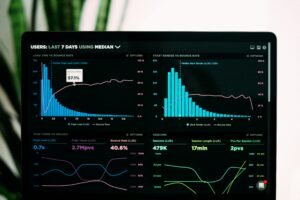Ever wondered how business analytics is shaping the future? Let’s get into a world where data isn’t just numbers on a screen—it’s the secret sauce driving strategic decisions. The global business intelligence market is set to skyrocket from $29.42 billion in 2023 to a whopping $63.76 billion by 2032. That’s a lot of data crunching! In this post, we’ll explore key trends and insights that’ll make you see the future of business analytics in a whole new light. Ready to find out on some data magic? Let’s go!
The Current Landscape of Business Analytics
Business analytics (BA) is all about getting into historical and current data to pull out valuable insights. Imagine using techniques like data mining, which digs deep into data to find patterns, and data preparation, which gets the data ready for analysis. Then there’s predictive analytics, which takes that data to forecast future outcomes. These techniques help businesses make smarter decisions and stay ahead of the game. No wonder the global business intelligence (BI) market was worth $29.42 billion in 2023 and is set to hit $63.76 billion by 2032. That’s huge!
Here are some of the critical current trends in business analytics:
- Data Fabric: Seamlessly connects different data sources for easier access and processing.
- Augmented Analytics: Uses AI to automate data prep, analysis, and visualization.
- Citizen Data Scientists: Empowers non-techy folks to work with data.
- Data Privacy & Security: Focuses on keeping data safe and compliant.
- Data Storytelling: Turns raw data into easy-to-understand stories.
Emerging Technologies Shaping the Future of Business Analytics

Artificial intelligence (AI) is transforming business analytics by streamlining data preparation through automated ETL processes, freeing teams to focus on analysis and smarter decision-making. Predictive analytics uses historical and live data to forecast trends, helping businesses anticipate demands and optimize strategies, while prescriptive analytics provides actionable recommendations to address potential challenges. Additionally, Natural Language Processing (NLP) simplifies data access, allowing non-technical users to gain insights through intuitive queries. Together, these AI-driven technologies make business analytics more efficient, inclusive, and impactful.
Trends in the Future of Business Analytics
Staying ahead of business analytics trends is vital for companies to remain competitive, as the evolving landscape offers opportunities for smarter decisions, efficiency, and growth. Key trends shaping the future include data fabric for seamless data access, augmented analytics for automating processes, and the growing role of citizen data scientists to bridge talent gaps. Additionally, data privacy and security remain priorities, while data storytelling emerges as a crucial tool for transforming complex information into accessible insights.
1. Data Fabric
Data fabric is all about making it easier to access and process data, no matter where it’s stored. It connects different data sources seamlessly, allowing businesses to pull insights without jumping through hoops. Imagine having a unified layer that ties all your data together, making it super easy to find what you need. This is a big deal because it saves time and makes data analytics more efficient.
2. Augmented Analytics
Augmented analytics is like having a supercharged assistant for your data tasks. It uses AI to automate the tedious parts of data preparation, analysis, and even visualization. You don’t have to spend hours cleaning data or figuring out how to present it. Augmented analytics does the heavy lifting, so you can focus on interpreting the results and making strategic decisions. It’s like having a personal data scientist on speed dial!
3. Citizen Data Scientists
The demand for citizen data scientists is skyrocketing. These are people who aren’t traditional data scientists but have enough skills to work with data effectively. With a shortage of specialized talent, businesses are turning to these non-traditional experts to bridge the gap. Citizen data scientists can use user-friendly tools to analyze data and generate insights, making data analytics more accessible to everyone in the organization.
The Role of AI in Future of Business Analytics

AI is transforming business analytics by delivering personalized insights and enabling real-time decision-making. AI-powered BI solutions analyze data patterns and past behaviors to offer tailored recommendations, helping businesses make smarter, faster decisions. Acting like a virtual assistant, AI provides exactly what is needed, when it’s needed. Combined with machine learning, it ensures businesses can respond instantly to changes, keeping operations efficient and strategies aligned with real-time demands.
Here are 5 main AI-driven business solutions:
- Personalized insights: tailored recommendations based on user behavior.
- Real-time Data Analysis: Instant insights for quick decision-making.
- Predictive Analytics: Forecasting future trends and outcomes.
- Automated ETL Processes: Streamlining data extraction, transformation, and loading.
- Natural Language Processing (NLP): Making data accessible to non-technical users.
Case Studies: Successful Implementations of Business Analytics
Case studies provide valuable insights into the real-world application of business analytics, showcasing successes, challenges, and lessons learned. In healthcare, analytics-equipped medical devices deliver real-time insights, enabling faster, more accurate decisions and improving patient care. Similarly, in education, real-time performance data helps teachers identify student needs and provide personalized support, ensuring no one falls behind. These examples highlight the transformative power of business analytics across industries.
- Medical Devices: Real-time insights for better patient care.
- Education: Real-time performance data for personalized teaching.
- Cash Management: Offering new services based on real-time insights.
Prepared for the Future: Skills and Tools for the Future of Business Analysts

Case studies provide valuable insights into the real-world application for the future of business analytics, showcasing successes, challenges, and lessons learned. In healthcare, analytics-equipped medical devices deliver real-time insights, enabling faster, more accurate decisions and improving patient care. Similarly, in education, real-time performance data helps teachers identify student needs and provide personalized support, ensuring no one falls behind. These examples highlight the transformative power of business analytics across industries.
- Tableau: Great for data visualization.
- Python: Essential for data analysis and machine learning.
- SQL: Crucial for managing and querying databases.
- Power BI: Excellent for business analytics and reporting.
- R: Perfect for statistical analysis.
Conclusion
This exploration of the future of business analytics highlighted essential techniques like data mining and predictive analytics, along with emerging technologies such as AI and prescriptive analytics. Future trends, including data fabric, augmented analytics, and citizen data scientists, promise to reshape the field. We also discussed AI’s role in personalizing insights, examined impactful case studies, and outlined key skills and tools for future analysts. With a bright future ahead, staying informed is key to maintaining a competitive edge.
FAQ
What is the future of business analytics?
The future of business analytics is bright, with continuous growth expected. As companies rely more on data, the demand for skilled analysts will increase.
What is the future of business analysis?
Business analysis will likely evolve with emerging technologies like AI and predictive analytics driving better decision-making. Analysts will become more integral in strategic planning.
Is business analytics a growing industry?
Yes, business analytics is a rapidly growing industry. Businesses increasingly rely on data to guide decisions, driving the need for more analytics professionals.
Is business analytics a good career path?
Absolutely, business analytics offers a promising career path. With high demand and competitive salaries, it’s a rewarding field for those interested in data and strategy.




